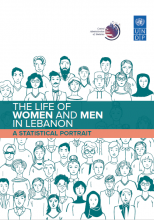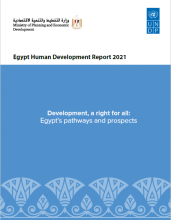Poverty
The Arab region witnessed an improvement in its Human Development Index (HDI) [1], an index which combines three dimensions of human development, namely health, education and living standards, from 0.618 in 2000 to 0.708 in 2021. In fact, this overall gain hides regional variations; while the HDI reached a value of 0.911 in the United Arab Emirates, it registered a low of 0.455 in Somalia.[2] Nonetheless, following the COVID-19 crisis, Human development faced an unprecedented hit in 2020 since its inception in 1990, a setback in the HDI index value: a decrease of 0.98 percent.[2]
Despite this positive overall trend in human development, poverty remained one of the paramount challenges for several countries in the region, accompanied by political and economic circumstances that led to a regression in economic growth, unstable social conditions and striking differences in living standards.[3][4] According to the latest statistics by UN-ESCWA, around 131 million people in the region can be classified as poor due to the COVID-19 pandemic.[5]
Poverty rates have particularly soared in countries of conflict. The conflict has brought Yemen to the verge of famine. While around half of the Yemeni population was considered poor before the crisis, poverty now affects 71% to 78% of Yemenis, with women being the most vulnerable. The UN estimated that 24.1 million people in 2023 were at risk of hunger and disease, and roughly 14 million were in acute need of assistance.[6] In Syria, the UN estimates that 15.3 million people were considered in need of humanitarian assistance in 2023 (a 5 percent increase from 2022), in the world’s second-worst humanitarian crisis after Yemen.[7] According to the United Nations, 90 percent of Syrians live below the poverty line, compared to 28 percent in 2010.[8] High-income inequality rates have also persisted within and across countries. GINI coefficients are very high in the region reaching 0.874 in 2020 up from 0.828 in 2019 while the global figure barely inched up from 0.885 to 0.889.[9]
Due to limited data coverage and measurement challenges linked to the irregularity of conducting national household surveys, obtaining an average “poverty headcount ratio” for the region is difficult to attain.[10] That said, there is also a dearth of updated statistics on incidences of poverty, as measured by national poverty lines. However, according to the latest version of the “Survey of Economic and Social Developments in the Arab Region released by ESCWA in December 2022, poverty, measured against national poverty lines increased to affect more than one-third of the region’s population excluding Gulf Cooperation Council countries and Libya. The Survey expects a further rise in poverty levels in the next two years, reaching 36% of the population in 2024.
Before the COVID-19 pandemic, the region needed 33.3 million new jobs to be created between 2020 and 2030 to reduce the unemployment rate to 5 percent . The outbreak of COVID-19 and the resulting lockdown had a deeper impact on the poor and more vulnerable, namely because of increasing prices, job loss, loss of remittances, and the difficulties accessing basic services such as education and health care which added more hardship on the poor and most vulnerable groups.[11]
While Multidimensional Poverty Index registers a rate of 0.074 for the Arab region, It is estimated that 6.9 percent of the population in the Arab region live in severe multidimensional poverty and 9 percent are vulnerable to multidimensional poverty. [12]
In Lebanon for example, former forecasts predicted an increase of headcount poverty from 28 percent in 2019 to 55 percent in 2020. The corresponding increase in extreme poverty is from 8 to 23 percent. This means that the total number of poor among the Lebanese population is 1.1 million and 2.7 million for the lower and upper poverty lines. The latter increased by 1.3 million persons from what was estimated by the pre-COVID-19 scenario.[13] Moreover, recent estimation [14] reveals a massive increase in the proportion of poor in 2022 compared with 2018 where under the most optimistic scenario, at least three out of five people in the country now live in poverty.
This overview has been updated by the ADP team based on the latest available data as of August 2023.
Sources:
[1] The Human Development Index (HDI) is a summary measure of average achievement in key dimensions of human development, namely health, education and standard of living. The health dimension is assessed by life expectancy at birth, the education dimension is measured by mean of years of schooling for adults aged 25 years and more and expected years of schooling for children of school entering age and the standard of living dimension is measured by gross national income per capita.
[2] United Nations Development Programme (UNDP). 2023. HDI Data Center. [ONLINE] Available at: https://hdr.undp.org/data-center/documentation-and-downloads [Accessed 13 August 2023].
[3] United Nations Economic and Social Commission for Western Asia (ESCWA), League of Arab States (LAS), United Nations Children's Fund (UNICEF) and Oxford Poverty and Human Development Initiative (OPHI), 2017. Arab Multidimensional Poverty Report. [ONLINE] Available at: https://www.unescwa.org/sites/www.unescwa.org/files/publications/files/multidimensional-arab-poverty-report-english_0.pdf [Accessed 13 August 2023].
[4] The Multidimensional Poverty Index (MPI) developed for the Arab Region is composed of three dimensions: education, health and living standards and twelve indicators. The Regional MPI does not take into consideration the income dimension. Ten countries are covered: Jordan, Tunisia, Algeria, Egypt, Morocco, Iraq, Comoros, Mauritania, Sudan, and Yemen.
[5] United Nations: Economic and Social Commission for Western Asia, LAS and other UN agencies. 2023. Second Arab Multidimensional Poverty report [ONLINE] Available at: https://www.unescwa.org/sites/default/files/pubs/pdf/second-arab-multidimensional-poverty-report-english.pdf
[6] The World Bank. 2023. Yemen Overview. [ONLINE] Available at: https://www.worldbank.org/en/country/yemen/overview [Accessed 13 August 2023].
[7] UNOCHA. 2023. Syria: UNHCR Operational Update, May 2023. [ONLINE] Available at:
https://reliefweb.int/report/syrian-arab-republic/syria-unhcr-operational-update-may-2023-enar#:~:text=The%20Syria%20crisis%20entered%20its,per%20cent%20increase%20from%202022. [Accessed 13 August 2023].
[8] United Nations. 2023. Security Council. [ONLINE] Available at: https://press.un.org/en/2023/sc15339.doc.htm [Accessed 13 August 2023].
[9] UNESCWA. 2022. Rising wealth inequality in the Arab region amid COVID-19. [ONLINE] Available at: https://www.unescwa.org/sites/default/files/news/docs/22-00183_rising_wealth_inequality_in_the_arab_region_amid_covid-19_-policy-brief-en.pdf [Accessed 13 August 2023].
[10] The World Bank. 2023. World Development Indicators (WDI). [ONLINE] Available at: https://databank.worldbank.org/data/reports.aspx?source=world-development-indicators [Accessed 13 August 2023].
[11] UNESCWA. 2021. Towards a Productive and Inclusive Path. Job creation in the Arab Region. [ONLINE] Available at: https://www.unescwa.org/sites/default/files/pubs/pdf/productive-inclusive-path-job-creation-arab-region-english_0.pdf [Accessed 13 August 2023].
[12] UNDP and OPHI. 2023. Multidimensional Poverty Index 2023. [ONLINE] Available at: https://www.undp.org/turkiye/publications/2023-global-multidimensional-poverty-index-mpi [Accessed 13 August 2023].
[13] United Nations: Economic and Social Commission for Western Asia ESCWA. 2021. Wealth distribution and poverty impact of COVID-19 in Lebanon. [ONLINE] Available at: https://www.unescwa.org/sites/www.unescwa.org/files/publications/files/wealth-distribution-poverty-impact-covid-19-lebanon-english.pdf [Accessed 1 April 2021].
[14] Economic Research Forum. 2023. Measuring poverty in Lebanon in the time of economic collapse. [ONLINE] Available at: https://theforum.erf.org.eg/2023/03/28/measuring-poverty-in-lebanon-in-the-time-of-economic-collapse/ [Accessed 13 August 2023].
Data Highlights
-
The Arab region witnessed an improvement in its Human Development Index (HDI) [1], an index that combines three dimensions of human development, namely health, education, and living standards, from 0.618 in 2000 to 0.708 in 2021. In fact, this overall gain hides regional variations; while the HDI reached a value of 0.911 in the United Arab Emirates, it registered a low of 0.455 in Somalia




